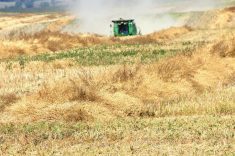Symptoms
Light green water-soaked spots develop on lower leaves and rapidly grow into dark brown spreading spots which are not limited by leaf veins, as occurs with early blight.
Under cool moist conditions typical of early morning, a white mildew develops on the under surface of lesions. These are surrounded by a pale green to yellow border.
Severe late blight gives plants a rotting smell.
Prevention
Use disease-free certified seed of varieties resistant to late blight.
Keep equipment and storage clean. Don’t leave tubers or debris in cull piles for long.
Read Also

Alberta researcher helps unlock the economics of farming
Lethbridge Polytechnic researcher helping agriculture producers with decision-making tools in economic feasibility
Don’t grow potatoes in the same area each year.
Increase spacing to reduce canopy density. Manage irrigation to avoid prolonged wet periods.
Scout fields and destroy hot spots of infection. Be aware of weather conditions that favor the disease.
Control weeds that suffer from the same disease, such as hairy nightshade.
Fungicide
Start using before disease develops and carry through to harvest.
Follow label directions.
Rotate fungicide groups or use tank mixes of different fungicides.
Organic farmers might be able to use copper-based fungicides.
Make sure all foliage, top to bottom of canopy, is covered.
Harvest
Harvest only when all of the vine is dead.
Avoid areas with suspicious shaded or wet areas during main harvest. Keep them separate.
Grade potatoes and remove infected tubers before going into storage.
Maintain proper air flow, humidity and temperature in storage.
For more information:
Manitoba Potato Disease Hotline: 800-428-6866.
Manitoba Agriculture web page, www.gov.mb.ca/agriculture/under News and Forecasts.
Saskatchewan Blight Hotline: 888-419-SPUD (7783).














